Horseback Riding at Dead Horse Ranch State Park
Horseback riding at Dead Horse State Park in Cottonwood, Arizona was more exciting than the name sounds. For one thing, we were saddled atop healthy living horses. They tend to move faster than the dead ones. The state park has an unusual name. In the late 1940s, the Ireys family was looking to move from Minnesota and buy a ranch in Arizona. They looked at several properties for sale and at one ranch there was a dead horse by the side of the road. When Mr. Ireys asked the children which property they liked best, the answer was unanimous. They chose the ranch with the dead horse. The family named it Dead Horse Ranch. When Arizona State Parks acquired the ranch it 1973 the Ireys put retaining the name into the contract.
The trail ride business run out of the park is managed by the Ireys family. Everyone was friendly as they helped us into the saddle. Our guide, Adrianna, was the granddaughter of one of the Ireys children. As we rode, she told us plenty of pioneer stories, many of them involving her grandfather. She told us her grandfather is still alive and riding horses in his late 70s, shortly after pointing out the two pine trees which mark the location of the old ranch house where her grandfather took his first steps.
For a horseback ride in Arizona the landscape sure was green. Dead Horse Ranch State Park is located along the shores of the Verde River where the banks are lined with towering cottonwood trees, Arizona sycamores, and desert willow. The trees provide shade and relief from the desert sun. Our guide points to a large black hawk nest perched high atop one tree.
The ride began with the horses walking past the two big lagoons inside Dead Horse State Park. The tiny ponds are picturesque, lined with trees, reeds, and fishermen dangling their poles. The ponds are framed by nearby hills and distant mountains. The ponds are home to fish, turtles, ducks, hawks, herons, raccoons,and otters.
Our ride took us across the creek. The creek was the Verde River. In a wetter, greener state, such a body of water might be referred to as a creek or stream but in a desert state like Arizona this is a full-fledged river. In some ways the creek crossing is a little hokey. The riders and horses cross the creek, wander about twenty feet downstream, and then cross back. It reminds me of the old joke — Why did the chicken cross the road? Because it could. Crossing the creek does make for some good photo ops and feels a little dangerous to novice riders like ourselves.
The best part of crossing the creek is how it reveals the personalities of the individual horses. One horse takes his time, cautious about his footing. Another horse pauses to cool his belly in the flowing waters. My horse barges across the river. Madison is riding a horse named JD. Tina is riding Festus and I am astride the biggest horse of all, a beautiful dappled gray named Bonita. Our guide rides a horse called Blaze. Blaze was named after the nearby Blazing M Ranch a place where western themed vaudeville shows take place with rousing sing alongs and booing the villain. Blaze was a part of the show and after hearing his musical cue would race around the building twice before rising up on his hind legs and dancing to the conclusion of the song. When the Blazing M Ranch was sold, Blaze was purchased by Dead Horse. The new owners tried to buy back their equine star, but Adrianna had grown rather attached to the intelligent beast. Blaze is not for sale.
Our guide shouted, I am sure you have noticed by now that Bonita produces a lot flatulence.
I replied, At least we have something in common.
We used to have one horse, our guide told us, that was afraid of his own farts. We couldn’t help but laugh but it was sort of sad too.
Madison was having some problems sitting atop JD. JD kept deciding to stride into the scrub brush and scratch his belly. Madison was a little too lady like to insist JD get back on the trail so he didn’t. At least not until that belly itch was greatly relieved.
Our ride swung us by an old basketball hoop and court. The old ranch used to hire lots of cowboys and sometimes Native Americans to work as cowboys. The cowboys and Indians liked to shoot hoops and of course the game they played was H-O-R-S-E.
We rode past one giant cottonwood tree, one that Adriannas grandfather claimed to have planted. I wasn’t buying it. That tree was at least 200 years old. As we rode a little further our guide pointed to a shallow cave located up high on a nearby hill. As a little kid, her grandfather used to climb up to that cave and crawl inside. He claimed it was loaded with pottery and arrowheads. Now the cave is used only by mountain lions.
We rode back to the corrals and were greeted by Grandfather Ireys himself, with a smile on his face and helping hand for anyone struggling to get out of the saddle.
I mentioned the old cave to him.
With a smile he said, Back when I was a boy we didn’t go to the store to buy a toy — we made them ourselves.
